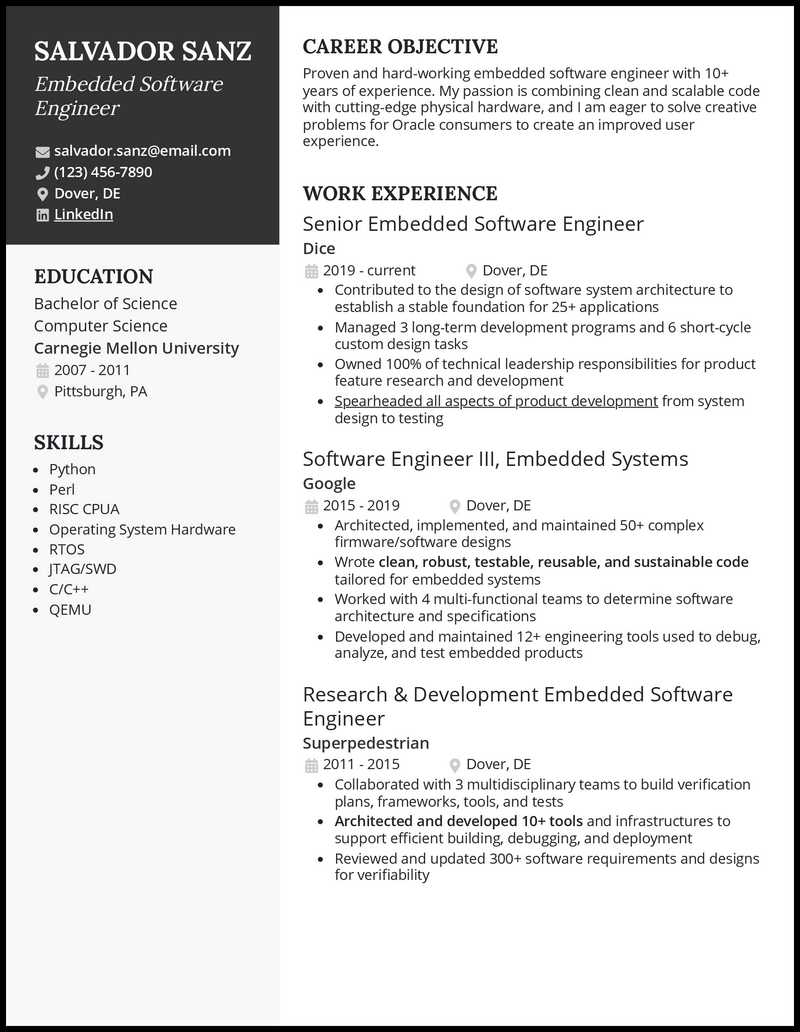Unlock your next career move with definitive embedded software engineer resume—with a resource featuring proven resume examples, smart tools to build a resume, and step-by-step advice on writing a cover letter that gets hiring managers’ attention.
This guide will show you how to demonstrate your technical expertise with impact and core skills, so your application rises to the top.
Here’s what we’ll cover:
- ↪ 5 embedded software engineer resume samples to draw your inspiration from
- ↪ A clear breakdown of what makes technical resumes succeed—and the pitfalls to avoid
- ↪ How to position yourself as a top candidate so your resume never gets overlooked
Why this resume works
- Sending a cookie-cutter embedded software engineer resume is like lobbing a grenade into your career plans. Tailoring your masterpiece can have the opposite effect. How about we show you the ropes?
- Start by digesting the job posting—read it over once, twice, whatever it takes. Then, scribble down all the relevant keywords, skills, and expectations you find.
How to Write an Embedded Software Engineer Resume

Landing a top embedded software engineering job begins with writing a resume that clearly showcases your technical expertise, measurable impact from your past, and career focus—using proven resume templates to present your qualifications with maximum clarity.
Summary
Build the perfect embedded software engineer resume by showcasing technical skills, measurable project results, and role-tailored achievements—presented in a clear format and complemented by a sharp cover letter that seals the deal.
Before you can confidently submit your application, fine-tune every detail with a resume checker to ensure your skills and select achievements align perfectly with what hiring managers expect.
Key things this guide will cover:
- Essential technical and soft skills employer won’t negotiate about
- Presenting your achievements in a convincing way
- Structuring your resume for ATS and recruitment teams
- Matching your pitch to the job description

Set a professional tone with a compelling summary statement
Hook recruiters with an irresistible summary profile, announcing that you’re the perfect candidate for the open embedded software engineer job. In your statement, tell them who you are, what your experience is, what your core competencies are, and what value you bring if hired.
Be careful not to stretch it beyond the liking of the hiring manager— use two to three sentences that capture your skills in system programming, firmware design, and problem-solving in an impactful and clear manner.
To refine this section for the liking of application screening bots and potential employers, use a summary generator to craft a professional introduction and then tailor it to the role’s needs.
Example
Embedded software engineer with 10 years of experience building real-time systems on ARM Cortex-M using FreeRTOS and Zephy. Reputable for cutting firmware update time by 68% across 120K+ devices. Focused on efficient code that bridges hardware and software in connected products.

Make a mark with your exceptional embedded software engineering tech stack
Just like you wouldn’t ask a dentist to do your plumbing, recruiters want to make sure you have the right tools for their embedded software engineer role.
Since embedded software engineering is such a blanket term and embedded systems change so drastically from one company to another, it is crucially important that you update your “skills” section for each role you apply to.
Here, recruiters are looking for a reason to throw your resume in the “no” pile. Don’t give them that reason!
Read the job description and include any skills mentioned that you know (i.e. that you’d be comfortable being interviewed on).
9 Top Embedded Software Engineer Skills
- C/C++
- Algorithms
- Micro-controllers
- Perl
- Python
- Design patterns
- Parallel programming
- Protocols: I2C, LIN
- IoT

Showcase your past accomplishments in equally high-stake roles
Now that you’ve passed the “skills” test, it’s time to showcase what you’ve done in your past roles.
The key is to focus on your impact, not on a list of your job responsiblities.
Talk about your specific work within the scope of a project then talk about the outcome of the overall project. This is the place to give context for your technical skills.
If a particular project you worked on comes to mind as you read the job description of the role you’re applying to, be sure to include it.
Here are a few examples:
- Built custom software in C++ for a micro-controller within an AC unit that reduced the cost of annual maintenance by 6%
- Improved the speed of an embedded system by 17% by changing the microprocessor without changes in materials cost
- Created automated testing infrastructure for custom code written for embedded system for the entire team which reduced error rates by over 50%
- Collaborated with leadership to come up with cost saving measures within product and re-wrote C++ code to accommodate new materials, saving ~$500K annually

Add embedded software engineer-related education
Even for a technical field, relevant education sets a strong foundation for your technical credibility. List your degree(s) in computer engineering, electrical engineering, or computer science prominently, starting with the most recent, and provide details about the school’s name, location, and years of study.
If you recently undertook any advanced coursework, such as in embedded systems, real-time operating systems (RTOS), or microcontroller programming, spotlight it in this section to demonstrate your specialized knowledge.
Academic projects, especially those focusing on hardware/software integration, can also underscore your unique abilities.

Establish authority with industry-specific certifications
Two ways to validate your technical prowess are through direct work done and certifications. The latter, certifications, are like yardsticks of your knowledge depth in a particular field, and they can convince recruiters to hire you because of your commitment and professionalism.
Including these credentials boosts trust and improves your visibility in applicant tracking systems (ATS).
Most importantly, pair certifications with context—explain how you applied the knowledge to real-world projects for maximum impact.
Some good examples to have on your resume are:
- ARM Accredited Engineer
- Embedded Systems Certification
- CompTIA Linux+

Format your resume focusing on ATS and the recruiter
We can’t stress enough that your resume must pass automated filters before being reviewed by a real human. Use a clean format, standard fonts and sizes, clear headings, and consistent spaces for that to happen.
Use a resume parser to ensure that you’ve used a good measure of keywords from the job ad, structured your content right, and aligned every detail to the expectations of the role and industry.

Use role-related active verbs and key phrases from the job ad
Strengthen your work experience bullet points by incorporating active verbs like “developed”, “optimized”, “implemented”, “integrated”, and “debugged”. Trace and find industry-specific keywords such as RTOS, C/C++, device drivers, firmware, IoT, and embedded Linux and spread them across your bullet points. The endgame is to ensure your resume resonates with recruiters while ranking higher in digital searches.
Top 5 tips for your embedded software engineer resume
- Soft skills without context are meaningless
- Imagine someone came up to you and said, “I am organized.” One, you’d wonder why they’re talking to you. And two, you would have no context for what they’re talking about.
- It’s all about your impact
- Your resume should not just be the bullet points from your job description. Rather, they should be the outcome of those responsibilities. So, instead of saying “managed embedded system,” you might say, “improved efficiency of embedded system by 7%,” for example.
- Specificity is key
- Because there are so many different kinds of embedded systems, the role of an embedded developer changes so much from role to role. That’s why your work experience should be as specific as possible in terms of what tools and technologies you’ve worked with.
- Focus on your work experience
- As soon as you have some real-world experience under your belt, your work experience should be the focus of your resume. A good rule of thumb, it should take up at least 75 percent of your resume. So, for example, if you’re 10 years out of school you don’t need to list all the relevant classes you took while in school.
- You don’t need a career summary
- Unless your career summary is going to tell a recruiter something new, it’s better to leave it out in favor of more work experience. A good way to make a summary valuable is to focus on your total career impact (in terms of revenue created, time saved, etc..).

Key takeaways
- Kick off with a powerful summary statement that sets the tone for your expertise
- Include your education in embedded systems
- Leverage certification from relevant professional bodies
- Optimize your content for ATS and recruiters
- Pair strong verbs and role-specific keywords with skills and results
Embedded Software Engineer Resume FAQs

You’ll want to focus on changing two areas: your skills section and the projects you mention in your work experience. Read the job description and note any skills that are mentioned and any projects you’ve worked on that come to mind.
Your work experience can go back as far as you need as long as the work experience is relevant to the role you’re applying to. If an embedded developer job you held 15 years ago is hyper relevant to a role you’re applying to for example, you should definitely include it!
Your resume work experience bullet points should focus on the tools you used and the impact of what you did. Your AI cover letter is the place to give more context and more details about those projects on your resume.










